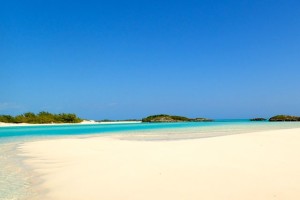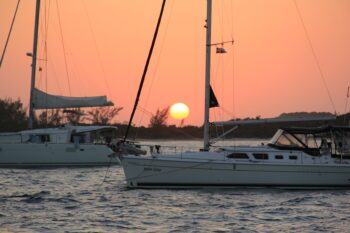Sunday, February 15th: We pulled up anchor just before dawn, knowing that the 40nm sail would take the better part of the day and that Norman Cay’s narrow channel and strong current required maneuvering in broad daylight. Jason very dutifully slogged 8nm directly into the 20k wind and its incessant barrage of choppy waves with the engine racing only to have Blue Moon make way at a snail’s pace. It was a bouncy, cold, unpleasant ride. I slept, showered, and poked my head out of the cabin just as we were rounding the tip of Eleuthera, where we were able to fall off and set the sails for a beautiful sail across the Exuma Sound, 15-20k on our beam. We were doing 8k! Go Blue Moon! (I realize if any non-sailors are reading this and have used the google to determine that 8 knots is only 9 miles per hour, they are thoroughly unimpressed. Blue Moon tends to sail around 4 knots, but often sails as slowly as 2 knots. With 15-20 knots of wind in your face, and waves breaking under your hull, I assure you that 8 knots feels very fast.)
Monday, February 16th: We went ashore for a run around Norman’s Cay. We’d run the island last year, at least a time or two, but extensive construction on the south end has changed the island significantly. The airstrip we used to jog across is now 5 times longer and fenced in. The road we used to jog to get to the north end is now two huge excavated pits full of water. I have no idea what they’re building, but it’s big. Somewhere between the dinghy, the construction site, the new detour around the airport, and the new bar we stopped at after the run, I lost the money I’d tucked away in my pocket. Jason had to run back to the dinghy (another 1.5m), dinghy back to the boat (and then row after the dinghy engine ran out of fuel), grab his wallet, dinghy back, and then bike back to the restaurant (on our folding bike he’d wisely grabbed from the boat), just to pay the check. Note to self: Let Jason carry the money.
 Tuesday, February 17th. We spent the day at our favorite beach, swimming in the gloriously warm and clean water, eating a picnic lunch and reading great new books (Brita: Story of a Shipwrecked Sailor; Jason: Longitude).
Tuesday, February 17th. We spent the day at our favorite beach, swimming in the gloriously warm and clean water, eating a picnic lunch and reading great new books (Brita: Story of a Shipwrecked Sailor; Jason: Longitude).
We came back to the boat for a bit so Jason could make dinner and Brita could exercise. Mid lunge, I noticed a woman on the bow of the boat behind us waving and saying “Hello.” I said “Hello” back, but thought maybe she was waving at the boat behind me, so I didn’t pay much attention. Then I saw her pointing to a man about 200 yards off her stern in the water. He appeared to be snorkeling and did not appear to be in distress. But she shouted, “Current!” and I quickly understood that the man had gotten swept away from his boat by the wicked current that rips through here. I also got stranded mid channel last year in this current, trying to return to the boat after a swim to a small sandy cay with a single palm tree. Jason, thankfully, is a much stronger swimmer than I am and was able to swim to the boat and bring the dinghy to rescue me. So when I saw the man far from the boat at max flood, I shouted to Jason that someone needed his help, and he sprung to action.
About half an hour later, Jason came back to the boat with quite a story. The man he rescued was in his mid-60s and had gone out to dive on his anchor to check its hold. By the time Jason got to him, he was bleeding, coughing, heaving and unable to speak. Jason manhandled him onto the dinghy, where he laid hunched over, completely exhausted. When he was finally able to utter some words, he said he thought he was going to die and was swimming with all his might against the current. The current was sweeping him away from the boat, but into land, with a shallow sandbar right behind him. If he’d just floated along with it, he quickly would have found himself on the sandbar or land, where he could have beckoned for help. Note to self: Don’t try to out swim a strong current; you will lose. And don’t swim without Jason ready at hand for a quick rescue.

Wednesday and Thursday were spent with hatches battened for the cold front that brought rain and lots of wind. Lots of cleaning, organizing, reading and board games, and a fair share of cabin fever. We’ll set sail tomorrow if the weather and tide allow.

Thanks for this Brita. I recall that day, Feb 16, 2015, very vividly because i was that guy that Jason fished out of the water at Normans Cay. Following is my account of it:
Feb. 16. Norman’s Cay.
Only 8 miles south was Norman’s Cay which offered good protection from the west and north. We left Allan’s Cay at 0900 into an easterly breeze at 15-20 kts. The sea was flat – perfect for the sail south.
We reached our first anchorage at Norman’s Cay just off the southwest beach at 1130. The tide was at at its lowest point and we touched bottom twice before dropping anchor. While the anchorage offered good protection from the east and southeast, the shelter was poor from the west and north. We knew the wind would remain from the east tonight and then would move to the west and north later in the week. So we decided to move.
We chose to re-anchor around the corner inside Norman’s Pond. This anchorage would give us better protection for the next several days of bad weather.
We had resigned to stay for a few days to wait out the fronts that were passing on Wednesday and Thursday. They would bring strong gusty winds from the west and then from the north.
I needed to reset the anchor once again on Tuesday since it dragged about 10 feet on Monday night, bringing the boat too close to our companion boat, Tempo. It made for a sleepless night on anchor watch for both of us.
At low tide, around noon on Tuesday, we reset our anchor about 200 feet further east in deeper water. After we set the anchor and made sure it was secure we went for a dinghy exploration of the bay for an hour or so.
Desire to see how well my anchor was set in its new position remained on my mind through the early afternoon. When I returned to the boat I donned my snorkeling gear and asked Joan to keep watch while I checked the anchor – with a caution that currents were stronger here than in the previous spot.
As soon as I got into the water and looked down I saw a giant stingray which must have measured 8 feet across. I pulled my mask and yelled to Joan to look at the stingray. She began to take pictures of the ray which stayed nearby for a few minutes.
Meanwhile, I put my mask back on and began swimming towards the anchor. Almost immediately, I saw that I wasn’t making any forward progress. I had in fact drifted backward off the stern of the boat by about 100 feet. Realizing the current had caught me, I put my head down and began swimming as fast as I could. A few minutes of this and I was exhausted.
When I looked up again I saw that I had lost further ground to the current. Despite my best efforts, JG was receding away quickly. Thoughts of being swept out to sea, and certain death, made me swim even faster, pushing my body well past its limits. Within seconds, I realized that I was not getting enough air through the snorkel to keep this up for long. Time to try something else.
I knew from our dinghy excursion that there was some shallow ground just northeast of our boat. I decided to go there in hopes of getting my feet on the ground. I began swimming in this direction and saw that I was able to make some progress relative to the bottom. My breathing was getting more difficult, however, as liquid was now beginning to form in my lungs. This made my situation even more dire. I was now hyperventilating because I was not getting enough air, and hyperventilation was worsening the condition in my lungs. I told myself to calm down, knowing that panic was my worst enemy.
Joan meanwhile, temporarily distracted by the stingray, had lost sight of me. When she looked up to where I was supposed to be, I was no longer there. At first, she thought I was diving for the anchor and waited for me to resurface. When that didn’t happen, she knew something was wrong and looked across the water for any sign of me. When she spotted me I was already too far from the boat for her to see me clearly or hear my calls. Realizing I was in distress, she ran to the front of the boat and began yelling and waving her arms to boats anchored nearby. Jason, on the Island Packet ‘Blue Moon’ closest to us, was alerted by his wife Brita who spotted Joan’s signals. He quickly jumped into his dinghy and set off in the direction Joan was pointing.
At the time, I had reached a toehold on the sand and was trying to regain my breath. Unfortunately, the liquid on my lungs was preventing me from getting air, and I was still expending energy just to stay in place. I spotted a power boat moving along the shore, so I took one flipper off and waved it in the air. Jason, approaching from behind, was able to see me wave the flipper, and was beside me in minutes.
Although in the dinghy and back to JG in short order thanks to Jason, I was still not out of danger. I had by then begun coughing blood which persisted for the next four or five hours. Jackie and Dave who arrived just as I was returned to the boat, provided medical assistance and some very sage advice which helped me immensely through the next several hours.
It took me a few days before I was able to fully absorb the experience of nearly having drowned in Norman’s Pond. Above all, I learned never to enter water with a current without a PFD, and always to have a ring and floating line extended from the boat. And I owed a debt of gratitude to all of the people, especially Joan, who saved me from an almost certain appointment with Davey Jones!